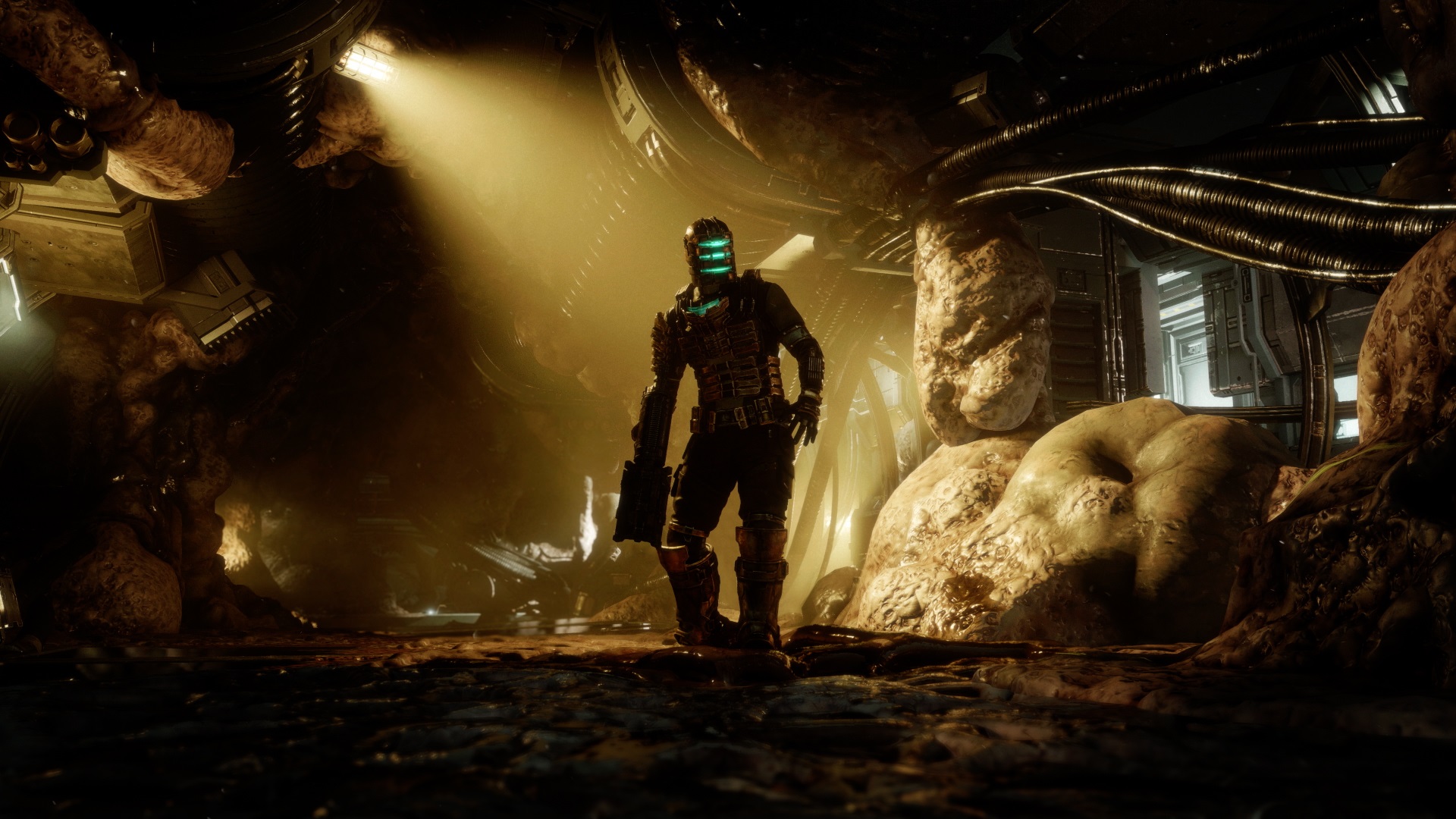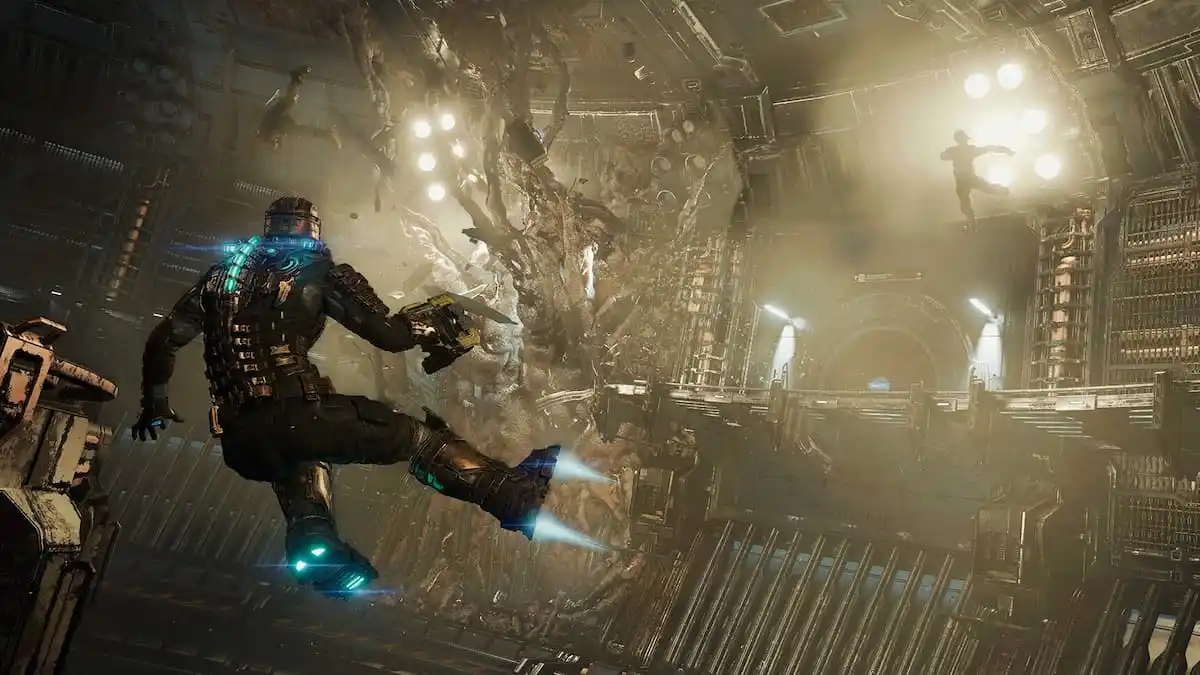A lot of people are understandably excited about the upcoming Resident Evil 4 remake, but I’ve been feeling a little left out. You see, unlike those people, I didn’t replay RE4 to death when I was younger. What I did play to death was Dead Space, and here we are with a beautifully realized remake right around the same time. Everyone wins (if they like horror games).
I was so completely immersed in Dead Space’s lore and mythos as a high schooler that a friend and I memorized the alphabet of the in-game cultist religion, Unitology. We would pass notes in class which would be inevitably intercepted by horrified teachers and classmates alike. We watched those weirdo animated spinoff short films. This was all around the height of Dead Space 2‘s popularity. It’s a shame they didn’t make another game after that. Oh well!
Anyway, this is all to say I have a lot of love for this series, and I’ll admit I was a little blasé when it came to the remake’s existence. Dead Space aged great, I thought. Then I compared the footage and, more importantly, spent time with the game.
There are some areas of Dead Space that haven’t aged quite so well, like Isaac’s complete lack of a voice. It was charming at the time, but since he speaks quite a bit in the sequel, it adds some discontinuity to the game’s overall feel. Luckily, voice actor Gunner Wright is back to voice Isaac — sparingly enough that it doesn’t change the foreboding mood, but enough that he no longer feels like an unshakeable, emotionless weirdo.
Besides this change, the graphics are obviously much improved, with the lighting, in particular, standing out. I’m in awe at the use of volumetric fog, which really makes the yawning hull of the USG Ishimura feel vast and cavernous. Lights interact with fog to create colorful and easily readable rooms of differing moods, something the original sometimes struggled with. The RIG, Isaac’s armor, is as timeless and iconic as ever, as are each of the game’s weapons and animations.
More significant changes are present mechanically as well, including revamped zero-gravity movement more in line with Dead Space 2. This not only allows for far greater exploration of these large sections but also means their combat is now fun instead of kind of awful.
One of my favorite tiny additions is the new power-switch mechanic. Instead of ceaselessly lugging those big power boxes around to turn things on, you’ll instead be tasked with rerouting power from one place to another. In a more creative twist on this mechanic, this once meant that I had to choose between being able to see with powered lights or being able to hear and breathe with life support capabilities. It adds to both exploration and combat, and it’s just one of the minor changes the team has excelled at seamlessly integrating.
There are still a few areas I would’ve liked to see some changes, however. Not having the ability to change both the sensitivity of aiming and the camera independently, while probably intentional in order to avoid making the game too easy, is a bit frustrating. I also feel the sound design is sometimes a bit muddy, and it can be very difficult to tell where enemies are in relation to your character (I was using a sound bar for this review, so your mileage may vary with headphones or surround sound).

One of the more defining changes highlighted in Dead Space‘s marketing was the addition of interior (and exterior) spaces between each of the game’s chapters, rather than strictly relying on the tram system. This means backtracking and physical traversal are more emphasized, increasing the feeling of being in the Ishimura. Another new mechanic, security levels, also incentivizes backtracking, as certain doors and containers can only be opened after completing portions of the story.
The combat is as great as ever, especially within the survival horror genre. Dead Space sort of carved out its own niche of limb-slashing action, which the original (and this remake) tries very hard to make clear to new players through a notoriously hilarious amount of environmental queues. Most guns are more than capable of shortening enemies by the approximate length of their shin bone, but some fill more niche roles, like the flamethrower. And in case you were wondering, the Pulse Rifle is still garbage.
The combat of Dead Space is a strong point, but the horror can become a bit tiring. This isn’t an issue with the remake mind you, but the overall direction of the original. A reliance on jumpscares (and I mean a lot of jumpscares) means you’ll quickly go from being startled to simply turning around and mowing down whatever popped out of a vent behind you. This isn’t to say the atmosphere isn’t incredible — it is! I just wish there was a little more tact in how the environment and the player interact.
But like I said, I’ve played this game a bajillion times — of course I’m not going to be scared of it anymore! Instead, I find it oddly… comfy? Walking slowly down each corridor, getting the jump on enemies trying to get the jump on me, is a satisfying time. Grabbing up all the collectibles and items I can find and carrying around a large metal pipe for ages just so I can have one free kill later on is the exact kind of stupid gamification I love about the genre.
Dead Space makes up for its lack of scares with its excellent pacing of new enemies, mechanics, upgrades, and weapons. The remake only reinforced my adoration for this game and its sequel, and I’m actually hopeful that we’ll see a Dead Space 2 remake in the future. There are some very welcome changes here, and I think every one of them is a hit. Dead Space doesn’t have the decidedly modern game feel of something like Resident Evil 2, but it also isn’t quite as much of a complete overhaul, and I’m glad for it. It’s a very well-done remake for a very finely aged game – doing just enough without breaking what works.
Now if you’ll excuse me, New Game+ is waiting.
This review is based on the PlayStation 5 version of the game. A copy of the game and all screenshots in this article were provided by Electronic Arts.










Published: Jan 26, 2023 11:00 am